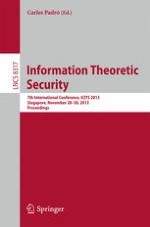2014 | OriginalPaper | Buchkapitel
Superposition Attacks on Cryptographic Protocols
verfasst von : Ivan Damgård, Jakob Funder, Jesper Buus Nielsen, Louis Salvail
Erschienen in: Information Theoretic Security
Aktivieren Sie unsere intelligente Suche, um passende Fachinhalte oder Patente zu finden.
Wählen Sie Textabschnitte aus um mit Künstlicher Intelligenz passenden Patente zu finden. powered by
Markieren Sie Textabschnitte, um KI-gestützt weitere passende Inhalte zu finden. powered by
